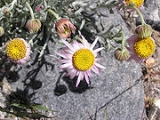
Erigeron parishii
Encyclopedia
Erigeron parishii is a species of flowering plant in the daisy family
known by the common name Parish's fleabane.
, where it is a federally-listed threatened species losing habitat to development and the limestone
mining industry on the north slope of the San Bernardino Mountains
.
can penetrate the carbonate soils to a depth of half a meter. Its stem and foliage are covered in silvery-white hairs and most of the leaves are basal and measure 3 to 6 centimeters long.
The erect stems have inflorescence
s of one to ten flower heads
, each between one and two centimeters wide. The head has a center of golden yellow disc florets and a fringe of up to 55 lavender, pink, or white ray florets.
.
The plant has a relatively high genetic diversity
for a narrow endemic, a measure that will decrease with the habitat fragmentation
that currently threatens it.
Asteraceae
The Asteraceae or Compositae , is an exceedingly large and widespread family of vascular plants. The group has more than 22,750 currently accepted species, spread across 1620 genera and 12 subfamilies...
known by the common name Parish's fleabane.
Distribution
This wildflower is endemic to San Bernardino County, CaliforniaSan Bernardino County, California
San Bernardino County is a county in the U.S. state of California. As of the 2010 census, the population was 2,035,210, up from 1,709,434 as of the 2000 census...
, where it is a federally-listed threatened species losing habitat to development and the limestone
Limestone
Limestone is a sedimentary rock composed largely of the minerals calcite and aragonite, which are different crystal forms of calcium carbonate . Many limestones are composed from skeletal fragments of marine organisms such as coral or foraminifera....
mining industry on the north slope of the San Bernardino Mountains
San Bernardino Mountains
The San Bernardino Mountains are a short transverse mountain range north and east of San Bernardino in Southern California in the United States. The mountains run for approximately 60 miles east-west on the southern edge of the Mojave Desert in southwestern San Bernardino County, north of the...
.
Description
This is a small perennial daisy reaching a maximum height of about 30 centimeters. The taprootTaproot
A taproot is an enlarged, somewhat straight to tapering plant root that grows vertically downward. It forms a center from which other roots sprout laterally.Plants with taproots are difficult to transplant...
can penetrate the carbonate soils to a depth of half a meter. Its stem and foliage are covered in silvery-white hairs and most of the leaves are basal and measure 3 to 6 centimeters long.
The erect stems have inflorescence
Inflorescence
An inflorescence is a group or cluster of flowers arranged on a stem that is composed of a main branch or a complicated arrangement of branches. Strictly, it is the part of the shoot of seed plants where flowers are formed and which is accordingly modified...
s of one to ten flower heads
Head (botany)
The capitulum is considered the most derived form of inflorescence. Flower heads found outside Asteraceae show lesser degrees of specialization....
, each between one and two centimeters wide. The head has a center of golden yellow disc florets and a fringe of up to 55 lavender, pink, or white ray florets.
Ecology
This plant usually grows on limestone substrates, or granite topped with a layer of limestone. It apparently requires very alkaline soilsAlkali soils
Alkali, or alkaline, soils are clay soils with high pH , a poor soil structure and a low infiltration capacity. Often they have a hard calcareous layer at 0.5 to 1 metre depth. Alkali soils owe their unfavorable physico-chemical properties mainly to the dominating presence of sodium carbonate...
.
Conservation
The same rock that the plant favors is also sought after for human use and limestone mining is the most significant threat to its habitat.The plant has a relatively high genetic diversity
Genetic diversity
Genetic diversity, the level of biodiversity, refers to the total number of genetic characteristics in the genetic makeup of a species. It is distinguished from genetic variability, which describes the tendency of genetic characteristics to vary....
for a narrow endemic, a measure that will decrease with the habitat fragmentation
Habitat fragmentation
Habitat fragmentation as the name implies, describes the emergence of discontinuities in an organism's preferred environment , causing population fragmentation...
that currently threatens it.

